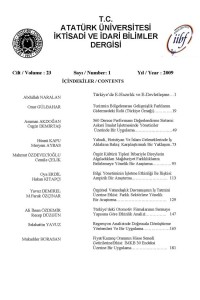TİCARİ DIŞA AÇIKLIK VE DOĞRUDAN YABANCI SERMAYE YATIRIMLARININ İŞGÜCÜ VERİMLİLİĞİNE ETKİSİ: 1980-2005 TÜRKİYE UYGULAMASI
Öz
Genel olarak girdiler ile bu girdileri kullanılarak elde edilen
çıktılar arasındaki ilişkiyi ifade eden verimlilik, girdilerin etkinliğinin bir
ölçütüdür. Son yıllarda verimlilik konusuna artan ilgi, özellikle verimliliği
etkileyen değişkenlerin neler olduğu sorusuna yanıt aramaktadır. Bu amaçla pek
çok çalışma yapılmıştır. Bu bağlamda, bu çalışmanın amacı, ticari dışa açıklık
ve doğrudan yabancı sermaye yatırımları ile verimlilik arasındaki ilişkiyi tespit
etmektir. Türkiye’de 1980 ile 2005 yılları arasını kapsayan 26 gözlem için eş
bütünleşme analizi yardımıyla, önce verimlilik ve ticari dışa açıklık arasındaki
uzun dönemli ilişki araştırılmış, ardından aynı yöntemle verimlilik ve doğrudan
yabancı sermaye yatırımları arasındaki ilişki test edilmiştir. Buna göre 20 yıllık
dönem sonunda ticari dışa açıklık işgücü verimliliğinin %38.7’sini açıklarken,
doğrudan yabancı sermaye yatırımları işgücü verimliliğinin %19.3’ünü
açıklamaktadır.
Anahtar Kelimeler
Doğrudan Yabancı Sermaye Yatırımları Ticari Dışa Açıklık İşgücü Verimliliği.
Kaynakça
- Alcala, Francisco ve Antonio Ciccone ( Mayıs 2004), “Trade and Productivity”, The Quarterly Journal of Economics, 614-646.
- Bwalya, Samuel Mulenga (2006), “Foreign Direct Investment and Technology Spillovers: Evidence from Panel Data Analysis of Manufacturing Firms in Zambia”, Journal of Development Economics, 81: 514-526.
- Cameron, Gavin, James Proudman ve Stephen Redding (1999),” Openness and Its Association with Productivity Growth in UK Manufacturing Industry”, Bank of England Working Papers, No:104.
- Crespo, Nuno ve Maria Paula Fontoura (2007), “Determinant Factors of FDI Spillovers –What Do We Really Know?” World Development, doi: 10.1016/j.worlddev.2006.04.001.
- Damijan, Jose P., Mark Knell, Boris Majcen ve Matija Rojec (2003), “The Role of FDI, R&D Accumulation and Trade in Transfering Technology to Transition Countries: Evidence From Firm Panel Data For Eight Transition Countries”,Economic Systems, 27:189-204.
- Gera, Surendra, Wulong Gu ve Frank C. Lee (1999), “Foreign Direct Investment And Productivity Growth: The Canadian Host- Country Experience”, Industry Canada Research Publications Program, Working Paper Number: 30, Kanada.
- Kimura, Fukunari ve Kozo Kiyota (2006), “Exports, FDI, and Productivity: Dynamic Evidence From Japanese Firms”, MMRC Discussion Paper Series, Discussion Paper No. 69, Tokyo.
- Madden, Gary ve Scott J. Savage (1998), “Sources of Australian Labour Productivity 74(227):362-372. 1950-1994”, The Economic Record,
- Miller, Stephen M. ve Mukti P. Upadhyay ,(2000), “The Effects of Openness, Trade Orientation, and Human Capital on Total Factor Productivity”, Journal of Development Economics, 63:399-423.
- Ramirez, Miguel (2006), “Does Foreign Direct Investment Enhance Labor Productivity Growth In Chile? A Cointegration Analysis”, Eastern Economic Journal, 32(2):205-220.
- Rodriguez, Carlos Alfredo (2000), “On the Degree of an Open Economy”, http://www.cema.edu.ar/~car/Advantage.PDF, (15.04.2007).
- Spilimbergo, Antonio, Juan Luis Londono ve Miguel Szekely (1999), “ Income Distribution, Factor Endowments, and Trade Openness”, Journal of Development Economics, 59:77-101.
- Squalli, Jay ve Kenneth Wilson (2006), “A New Approach to Measuring Trade Openness”, Economic Policy Research Unit Working Paper Series, Working Paper No. 06-07.
- The Conference Board and Groningen Growth and Development Centre, Total Economy Database, January 2008, http://www.conference-board.org/ economics/
- Uğur, Ali ve Frances Ruane (2004), “Foreign Direct Investment and Productivity Spillovers in Irish Manufacturing Industry: Evidence From Plant Level Panel Data”, International Journal of Economics of Business, 11(3):53-66.
- UUnctad, FDI Inflows, By Host Region and Economy, http://www.unctad.org, (23.07.2008).
- Valadkhani, Abbas (2005), “Sources of Iranian Labour Productivty”, Review of Middle East Economies and Finance, 3(3):203-218.
- www.dtm.gov.tr, www.tuik.gov.tr Notlar:
- Belirtilen oranlar çalışmada kullanılan ticari dışa açıklık verilerinden faydalanılarak elde edilmiştir.
Öz
Kaynakça
- Alcala, Francisco ve Antonio Ciccone ( Mayıs 2004), “Trade and Productivity”, The Quarterly Journal of Economics, 614-646.
- Bwalya, Samuel Mulenga (2006), “Foreign Direct Investment and Technology Spillovers: Evidence from Panel Data Analysis of Manufacturing Firms in Zambia”, Journal of Development Economics, 81: 514-526.
- Cameron, Gavin, James Proudman ve Stephen Redding (1999),” Openness and Its Association with Productivity Growth in UK Manufacturing Industry”, Bank of England Working Papers, No:104.
- Crespo, Nuno ve Maria Paula Fontoura (2007), “Determinant Factors of FDI Spillovers –What Do We Really Know?” World Development, doi: 10.1016/j.worlddev.2006.04.001.
- Damijan, Jose P., Mark Knell, Boris Majcen ve Matija Rojec (2003), “The Role of FDI, R&D Accumulation and Trade in Transfering Technology to Transition Countries: Evidence From Firm Panel Data For Eight Transition Countries”,Economic Systems, 27:189-204.
- Gera, Surendra, Wulong Gu ve Frank C. Lee (1999), “Foreign Direct Investment And Productivity Growth: The Canadian Host- Country Experience”, Industry Canada Research Publications Program, Working Paper Number: 30, Kanada.
- Kimura, Fukunari ve Kozo Kiyota (2006), “Exports, FDI, and Productivity: Dynamic Evidence From Japanese Firms”, MMRC Discussion Paper Series, Discussion Paper No. 69, Tokyo.
- Madden, Gary ve Scott J. Savage (1998), “Sources of Australian Labour Productivity 74(227):362-372. 1950-1994”, The Economic Record,
- Miller, Stephen M. ve Mukti P. Upadhyay ,(2000), “The Effects of Openness, Trade Orientation, and Human Capital on Total Factor Productivity”, Journal of Development Economics, 63:399-423.
- Ramirez, Miguel (2006), “Does Foreign Direct Investment Enhance Labor Productivity Growth In Chile? A Cointegration Analysis”, Eastern Economic Journal, 32(2):205-220.
- Rodriguez, Carlos Alfredo (2000), “On the Degree of an Open Economy”, http://www.cema.edu.ar/~car/Advantage.PDF, (15.04.2007).
- Spilimbergo, Antonio, Juan Luis Londono ve Miguel Szekely (1999), “ Income Distribution, Factor Endowments, and Trade Openness”, Journal of Development Economics, 59:77-101.
- Squalli, Jay ve Kenneth Wilson (2006), “A New Approach to Measuring Trade Openness”, Economic Policy Research Unit Working Paper Series, Working Paper No. 06-07.
- The Conference Board and Groningen Growth and Development Centre, Total Economy Database, January 2008, http://www.conference-board.org/ economics/
- Uğur, Ali ve Frances Ruane (2004), “Foreign Direct Investment and Productivity Spillovers in Irish Manufacturing Industry: Evidence From Plant Level Panel Data”, International Journal of Economics of Business, 11(3):53-66.
- UUnctad, FDI Inflows, By Host Region and Economy, http://www.unctad.org, (23.07.2008).
- Valadkhani, Abbas (2005), “Sources of Iranian Labour Productivty”, Review of Middle East Economies and Finance, 3(3):203-218.
- www.dtm.gov.tr, www.tuik.gov.tr Notlar:
- Belirtilen oranlar çalışmada kullanılan ticari dışa açıklık verilerinden faydalanılarak elde edilmiştir.
Ayrıntılar
| Birincil Dil | tr;en |
|---|---|
| Bölüm | Makaleler |
| Yazarlar | |
| Yayımlanma Tarihi | 27 Kasım 2010 |
| Yayımlandığı Sayı | Yıl 2009 Cilt: 23 Sayı: 1 |





